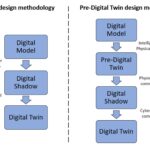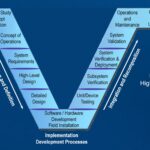Model-based system engineering (MBSE) uses digital twins, digital threads, and domain models to replace document-based information exchanges during the system development process. It is widely used with complex cyber-physical systems in aerospace, energy, healthcare, and transportation to define features, design, analyze and validate a system using virtual tools. For designers, MBSE is an expansive concept. For example, with MBSE, designers are involved not only with a single ECU but also in developing and implementing multiple features. MBSE speeds the design process; it can support collaboration across engineering disciplines and reduces paperwork.
This FAQ briefly reviews the traditional methods of systems engineering, looks at how MBSE is applied to cyber-physical system development, considers how MBSE can be used in system security management processes and closes by presenting how MBSE is used in pattern-based systems engineering (PBSE) to leverage the benefits of MBSE into larger communities of systems.
MBSE is replacing the concepts defined by the classic systems engineering ‘V’. The V model pictures the engineering lifecycle as a linear process moving forward in time (Figure 1). It begins with the decomposition of the system elements and requirements on the left side, moving from the top to the bottom of the V. System design, integration, testing, validation, production, and delivery are pictured on the right side, moving from the bottom to the top. The V model was developed to illustrate the processes and timelines related to a document-based system development process supported by engineering ‘silos.’ MBSE uses digital development processes and information exchanges to break down the silos and speed the development of complex systems.

The International Council on Systems Engineering (INCOSE) defines MBSE as the formalized use of modeling to develop and maintain system requirements, design, analysis, verification, and validation activities from the conceptual design phase, through development, and all phases of a product or system life cycle. MBSE is often implemented using the Object Management Group (OMG) systems modeling language (SysML), a general-purpose graphical modeling language for specifying, analyzing, designing, and verifying complex systems that include hardware, software, and other elements. Some of the benefits derived from using MBSE include:
- Standardization of the methods for developing, capturing, and managing system requirements, architecture, and design.
- Ability to identify and analyze the system environment in terms of a ‘system of systems.’
- Digital models serve as a single point of ‘truth’ for diverse engineering teams and enable detection of defects earlier in the development process.
- Digital threads facilitate interaction between various engineering disciplines and teams.
- Support for exploration of multiple solution options with minimal investment of time and resources.
The process of implementing MBSE can be viewed as five inter-related activities (Figure 2):
- Product definition
- Connected engineering
- Product validation
- Quality engineering
- Integrated program planning

A key tenant of MBSE is integrated digitization of all engineering groups, including electrical, electronic, mechanical, software, etc. Expanding on the five MBSE activities outlined above (Figure 3):
- Product definition includes requirements management, parameter management, function and system modeling, and decomposition of those elements into one or more multi-domain architecture(s) that provide a complete virtual product definition on which to base the digital twin.
- Connected engineering including systems development coordinating the activities of electrical, networking, software, mechanical, electronics, and specialties such as system on chip (SoC) designers to support cross-functional integration, early exposure and resolution of defects, domain verification and validation, and optimizing design decisions to manage risks.
- Product validation involves continuous engineering throughout the system development process and product lifecycle for design and performance optimization, multi-domain analysis, and multiple levels of virtual and physical testing to arrive at system verification and validation.
- Quality engineering to ensure that the design complies with all regulations and requirements from applicable industry standards, organizations, and government agencies. This continuous process monitors every design change throughout the development process and lifecycle to arrive at a safe, secure and reliable end result.
- Integrated program planning uses a digital thread to manage all the interconnected and dynamic activities and groups, keep the digital twin and related models relevant to the process, and provide a central repository for all data.

MBSEsec
The concepts of MBSE can be applied to the development of secure systems. MBSEsec is based on the ISO/IEC 27001 standard that establishes requirements for setting, implementing, operating, monitoring, reviewing, maintaining, and improving an information security management system (ISMS). Applying the five-bullet MBSE model to MBSEsec produces the following actions: define the risk assessment approach; identify risks; analyze and evaluate risks; identify and evaluate options for treatment of each risk; and define objectives and controls for the treatment of each risk. When applying MBSE techniques to secure system development, the ‘plan-do-check-act’ (PDCA) model used by ISO/IEC 27001 can be implemented in a series of steps (Figure 4):
- Plan – define the risk assessment approach and identify security requirements
- Do – define security objectives and allocate assets
- Check – model threats and risks using behavioral and structural security models and specifications
- Act – define and verify security controls

Like MBSE, the phases of MBSEsec are implemented in a recursive and even circular manner, not just linearly. And they apply throughout the product lifecycle of the secure system.
Pattern Based Systems Engineering
As future cyber-physical systems become increasingly autonomous, concerns about safety, security, and reliability extend beyond individual systems and encompass systems of systems. The U.S. Department of Defense (DoD) has identified PBSE as a critical methodology for future system design efforts. PBSE is an extension of MBSE principles and is expected to address systems that are 10x more complex, with a 10x reduction in modeling effort, involving engineers from a 10x larger community (extending beyond experts in individual systems), to more quickly develop more complete and consistent models. To advance PBSE development and use, INCOSE has established a Patterns Challenge Team within the OMG/INCOSE MBSE Initiative. The terms ‘pattern’ and ‘pattern methodology’ in PBSE refer to specific characteristics:
- S*Patterns are model-based and can be embodied in formal system models that are reusable and configurable and are, in turn, based on an underlying S*Metamodel. S*Patterns are essentially architectural frameworks that include large quantities of detailed data.
- The scope of S*Patterns covers entire systems or platforms, and S*Pattern applications are reusable and configurable models of broad-based systems of platforms.
A metamodel is the basis for implementing PBSE and is a model of other models. It provides a high-level structure for the models it describes. A metamodel can be embodied in database tables using SysML or other languages. The metamodel provides a relational and objective information model based on systematic methodologies and describes requirements, designs, and additional information in various S*Models such as verification, failure analysis, and so on (Figure 5).
 Figure 5: A structural view of a S*Metamodel used in PBSE. (Image: NDIA Ground Vehicle Systems Engineering and Technology Symposium)
Figure 5: A structural view of a S*Metamodel used in PBSE. (Image: NDIA Ground Vehicle Systems Engineering and Technology Symposium)
Summary
MBSE replaces the classic systems engineering ‘V’ linear system development process. In MBSE, document-based information exchanges between various engineering disciplines are replaced with modeling, digital twins, and digital threads that are recursive, updated in real-time and shared throughout the development teams. MBSEsec is a specific implementation of MBSE principles for developing secure systems based on ISO/IEC 27001. The Patterns Challenge Team within the OMG/INCOSE MBSE Initiative aims to promote the development and use of PBSE to address emerging autonomous and other systems of systems platforms that are 10x more complex, with a 10x reduction in modeling effort, involving engineers from a 10x larger community.
References
Manage the Complexity of Modern Vehicle Development with Product Definition and MBSE, Siemens
MBSE Wiki, International Council on Systems Engineering, INCOSE
MBSEsec: Model-Based Systems Engineering Method for Creating Secure Systems, MDPI applied sciences
Pattern Based System s Engineering, NDIA Ground Vehicle Systems Engineering and Technology Symposium
The System Engineering “V” – Is It Still Relevant In the Digital Age?, Boeing
What is MBSE?, Capella
What is SysML?, Object Management Group






